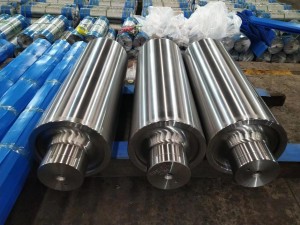In the steel rolling industry, the rolls used in cold rolling and hot rolling lines are crucial core components. Due to the different processes and usage environments of the two, there are also significant differences in the material selection of the rolls. We will explore in detail the differences in material selection between rolls used in cold rolling and hot rolling lines.
Firstly, there is a significant difference in the working temperature between the cold rolling line rolls and the hot rolling line rolls. Hot rolling lines are carried out at high temperatures and typically need to withstand temperatures as high as 1200 ℃. Therefore, the roll material of the hot rolling line must have excellent high-temperature performance and thermal fatigue resistance. Common materials include high chromium cast iron, high-speed steel, and heat-resistant steel. These materials not only maintain strength and hardness at high temperatures, but also resist oxidation and hot corrosion, thereby extending the service life of the rolls.
On the contrary, cold rolling lines are carried out at or near room temperature, so the rolls do not need to withstand high temperatures. However, during the cold rolling process, due to the high requirements for the surface quality of the sheet metal, the surface hardness and wear resistance of the rolls are particularly important. Cold rolling line rolls are usually made of materials such as alloy tool steel, carbon tool steel, or chrome plated steel. These materials have high hardness and wear resistance, which can ensure that the surface of the rolls is not easily worn during long-term high-strength use, thereby ensuring the surface quality of the product.
Secondly, the load and pressure of the rolls on the cold rolling and hot rolling lines are also different. The hot rolling line needs to compress high-temperature steel billets into various specifications of steel plates, and the rolls need to withstand great pressure and impact, so the material is required to have high strength and good toughness. The cold rolling line, due to being carried out at lower temperatures, mainly bears higher shear and friction forces on the rolls. Therefore, the material selection of cold rolling rolls focuses more on their wear resistance and fatigue resistance.
In addition, the production process of cold rolling line rolls usually involves more surface treatment processes, such as chrome plating, quenching, etc., to further improve their surface hardness and wear resistance. However, due to working in high-temperature environments, these surface treatment methods are not suitable for hot rolling line rolls. Instead, their performance is enhanced through the alloy composition and heat treatment process of the material itself.
In summary, there are significant differences in the material selection of rolls for cold rolling and hot rolling lines, mainly reflected in the different requirements for working temperature, load, pressure, and surface quality. Hot rolling line roll materials need to have excellent high-temperature performance and thermal fatigue resistance, while cold rolling line roll materials emphasize high hardness and high wear resistance. Understanding and correctly selecting suitable roll materials is of great significance for ensuring the stability of the rolling process and product quality. As always, we sincerely appreciate your support and business. Please do not hesitate to contact ssophie@welongchina.com if you have any questions or concerns. We look forward to continuing our partnership with you.
Post time: Jul-01-2024





